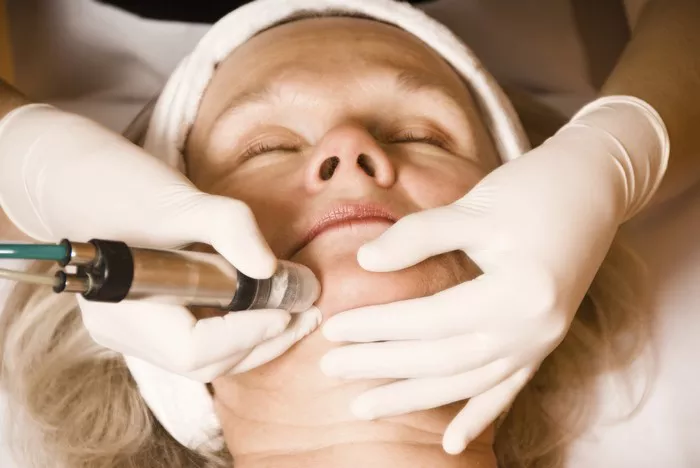Microdermabrasion is a popular non-invasive cosmetic procedure that is used to improve the appearance of skin. It involves using a special device to exfoliate the outermost layer of skin, which can help to reduce the appearance of fine lines, wrinkles, and other imperfections. While microdermabrasion is generally considered safe, there are risks and potential complications associated with the procedure. In this article, we will explore the potential risks of microdermabrasion and what you can do to minimize your risk of complications.
The Basics of Microdermabrasion
Microdermabrasion is a cosmetic procedure that involves using a special device to exfoliate the outermost layer of skin. The device typically uses a combination of suction and abrasive particles to remove dead skin cells and other debris from the skin.
The procedure is typically performed in a dermatologist’s office or medical spa and can take anywhere from 30 minutes to an hour to complete. After the procedure, patients may experience some redness and mild discomfort, but these side effects typically subside within a few hours.
The Risks of Microdermabrasion
While microdermabrasion is generally considered safe, there are risks and potential complications associated with the procedure. These risks include:
Skin Irritation: Microdermabrasion can cause skin irritation, especially if the procedure is performed too aggressively or if the patient has sensitive skin. This can lead to redness, itching, and even peeling.
Infection: Any time the skin is broken, there is a risk of infection. While the risk of infection with microdermabrasion is low, it is still possible, especially if the procedure is not performed in a sterile environment.
Scarring: In rare cases, microdermabrasion can cause scarring. This is more likely to occur if the procedure is performed too aggressively or if the patient has a history of keloid scarring.
Hyperpigmentation: Microdermabrasion can cause hyperpigmentation, which is a darkening of the skin. This is more likely to occur in patients with darker skin tones.
Eye Injury: If the microdermabrasion device is used too close to the eyes, there is a risk of eye injury. This is why eye protection is typically used during the procedure.
Bruising: Some patients may experience bruising after a microdermabrasion procedure, especially if they have thin or sensitive skin.
Allergic Reactions: Some patients may experience an allergic reaction to the abrasive particles used in microdermabrasion. This is more likely to occur in patients with sensitive skin.
Uneven Results: In some cases, microdermabrasion may result in uneven skin texture or color. This is more likely to occur if the procedure is not performed correctly or if the patient has underlying skin conditions.
Minimizing Your Risk of Complications
While the risks of microdermabrasion are relatively low, there are steps you can take to minimize your risk of complications. These include:
Choosing a Qualified Provider: When choosing a provider for microdermabrasion, it is important to choose someone who is qualified and experienced. Look for a board-certified dermatologist or plastic surgeon who has experience performing the procedure.
Following Pre-Procedure Instructions: Before your microdermabrasion procedure, your provider will give you instructions on how to prepare for the procedure. It is important to follow these instructions carefully to minimize your risk of complications.
Using Sunscreen: After your microdermabrasion procedure, your skin will be more sensitive to the sun. It is important to use sunscreen and avoid direct sunlight for at least a week after the procedure.
Avoiding Certain Products: After your microdermabrasion procedure, it is important to avoid certain products, such as retinoids and glycolic acid, which can irritate the skin.
Reporting Any Complications: If you experience any complications after your microdermabrasion procedure, such as excessive redness or peeling, it is important to report these to your provider immediately.
Managing Expectations: It is important to have realistic expectations about what microdermabrasion can and cannot do. While it can improve the appearance of skin, it is not a miracle cure for all skin problems.
Understanding Your Skin Type: It is important to understand your skin type and any underlying skin conditions you may have before undergoing microdermabrasion. This can help to minimize your risk of complications and ensure that you achieve the best possible results.
Conclusion
Microdermabrasion is a popular cosmetic procedure that can help to improve the appearance of skin. While the risks of microdermabrasion are relatively low, there are risks and potential complications associated with the procedure. These risks include skin irritation, infection, scarring, hyperpigmentation, eye injury, bruising, allergic reactions, and uneven results.
By choosing a qualified provider, following pre-procedure instructions, using sunscreen, avoiding certain products, reporting any complications, managing expectations, and understanding your skin type, you can minimize your risk of complications and enjoy the benefits of microdermabrasion.


